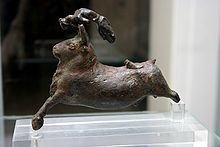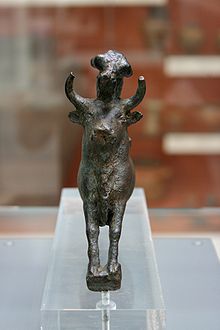- Minoan Bull-leaper
-
Bronze Group of a Bull and Acrobat 
Material Bronze Size L: 15.5 centimetres (6.1 in)
H: 11.4 centimetres (4.5 in)
W: 4.7 centimetres (1.9 in)Created 1600BC-1450BC Period/culture Late Minoan I Place Rethymnon, Crete Present location G12/1, British Museum, London Registration 1966,0328.1 The Minoan bull leaper is a bronze group of a bull and leaper in the British Museum. It is the only known largely complete three-dimensional sculpture depicting Minoan bull-leaping.[1] Although bull leaping certainly took place in Crete at this time, the leap depicted is practically impossible and it has therefore been speculated that the sculpture may be an exaggerated depiction.[2][1] This speculation has been backed up by the testaments of modern day bull leapers from France and Spain.[3]
Contents
Description
The group was cast in a single mould using the lost-wax casting technique. The group's homogeneity was demonstrated by analysing the composition of the bronze of bull and leaper: both contain about 96% copper and 1.5% tin, with 1% zinc.[4] The small amount of tin in the alloy would have made it difficult for the bronze to fill the mould, resulting in the missing lower legs of the leaper, and probably the arms.[2] Stylistically, the group is coherent, since the arched back of the leaper mirrors the flying gallop posture of the bull.
Background
Arthur Evans, the excavator of Knossos, first published this object in the Journal of Hellenic Studies.[5] Evans dated the bull-leaper to the Late Minoan I period, so that this object dates to approximately 1600 BC.[6]
It was acquired by the British Museum in 1966 as part of the collection of Captain Edward George Spencer-Churchill (1876-1964). He acquired it in Crete in 1921.[7] The object was widely known before its acquisition and display in the Museum. It was illustrated in several general books[8][9][10] and exhibited at the British Academy in 1936.[11]
Bull-leaping
Bull leaping and bulls in general are believed to have been an important part of Minoan culture; excavations at Knossos have revealed several frescos depicting bull-leaping.[12] It has been suggested bulls may have had some religious significance to them for example the large, exaggerated size of the bull compared to the human leaper may give an idea of the Minoans' reverence for the power of the animals.[1]
This object has been central to discussions of bull-leaping, since Arthur Evans used it as the basis for his reconstruction of the mechanics of the leap: the leaper grabs the bull's horns, executes a back flip onto the bull's back and then dismounts.[5] As John Younger has pointed out, although this reconstruction has become part of bull-leaping in the popular imagination, comparatively few Minoan depictions show exactly this schema. The majority show the leaper diving over the bull's horns onto the back.[13]
Media appearances
The bull-leaper was object 18[14] in the BBC Radio 4 Series A History of the World in 100 Objects. Week 4 of the series was 'The Beginning of Science and Literature': Neil MacGregor emphasised the importance of bronze, used to manufacture tools as well as art objects, and its central role in Mediterranean trade in the Bronze Age.
The BBC promoted A History of the World in 100 Objects with television adverts. One of these was a 30 second commercial featuring a Spanish recortador (bull-leaper) created by the ad agency Fallon Worldwide.[15]
See also
- Bull-Leaping Fresco
Notes
- ^ a b c "A History of the World - Object: A bronze statue of an acrobat leaping over a bull from the island of Crete.". BBC and British Museum. 22 September 2008. http://www.bbc.co.uk/ahistoryoftheworld/objects/eU0DV7kOQ5inxmklD__YIw. Retrieved 6 June 2010.
- ^ a b "Minoan bull leaper". British Museum. http://www.britishmuseum.org/explore/highlights/highlight_objects/gr/b/minoan_bull_and_acrobat.aspx. Retrieved 06.05.10.
- ^ "A history of the world in 100 objects". 1. BBC. Radio 4. February 10 2010. No. 18.
- ^ Craddock 1976, pp. 93–113
- ^ a b Evans 1921, pp. 247–259
- ^ "Collections Database Online". British Museum. http://www.britishmuseum.org/research/search_the_collection_database/search_object_details.aspx?objectid=399328&partid=1&searchText=minoan+bull+leaper&fromADBC=ad&toADBC=ad&numpages=10&orig=%2fresearch%2fsearch_the_collection_database.aspx¤tPage=1. Retrieved 4 June 2010.
- ^ Higgins, R. (1967). "Recent Acquisitions by the British Museum.". Archaeological Reports 13: 47–52.
- ^ Hall 1928, p. 172, fig. 221&222
- ^ Hutchinson 1962, p. 265, pl.16
- ^ Lamb 1929, p. 27, pl.6
- ^ Myres 1936, p. 9, 17
- ^ "Knossos - Minoan Art work". http://ancienthistory.about.com/od/bronzeage/ss/091008Minoan.htm. Retrieved 06.05.10.
- ^ Younger 1976
- ^ "A History of the World in 100 Objects". Radio Times. http://www.radiotimes.com/content/features/a-history-of-the-world-in-100-objects. Retrieved 2010-06-06.
- ^ "History of the World". Fallon. http://www.fallon.co.uk/historyoftheworld. Retrieved 6 June 2010.
References
- Craddock, Paul (1976), "The Composition of the Copper Alloys used by the Greek, Etruscan and Roman Civilizations. 1. The Greeks before the Archaic Period", Journal of Archaeological Science 3: 93–113
- Evans, Arthur (1921), "On a Minoan Bronze Group of a Galloping Bull and Acrobatic Figure from Crete. With Glyptic Comparisons and a Note on the Oxford Relief Showing the Taurokathapsia", Journal of Hellenic Studies 41: 247–259, ISSN 00754269, OCLC 486621953
- Hall, H R (1928), The Civilization of Greece in the Bronze Age (The Rhind Lectures 1923), Methuen, OCLC 493998189
- Hutchinson, R W (1962), Prehistoric Crete, Pelican books, A501, Penguin Books, OCLC 1683258
- Lamb, Winifred (1929), Greek and Roman bronzes, Methuen's handbooks of archaeology., Methuen, OCLC 1936690
- Myres, John (1936), British Archaeological Discoveries in Greece and Crete 1886-1936. Catalogue of the Exhibition Arranged to Commemorate the Fiftieth Anniversary of the British School at Athens, London: Royal Academy of Arts, OCLC 602565099
- Younger, John (1976), "Bronze Age Representations of Bull-Leaping", American Journal of Archaeology 80 (2): 125–137
Further reading
- Evans, Arthur (1921-35), The Palace of Minos at Knossos, Macmillan, OCLC 459432466
- Fitton, J Lesley (2002), Minoans, Peoples of the past (London, England), British Museum Press, OCLC 606932988, http://catalog.hathitrust.org/api/volumes/oclc/51652875.html
- Higgins, Reynold (1967), Minoan and Mycenaean Art, Thames & Hudson, OCLC 250899895
- Higgins, Reynold Alleyne (1970), The Greek Bronze Age, British Museum, ISBN 9780714112336
- Hood, Sinclair (1978), The arts in prehistoric Greece, The Pelican history of art, Harmondsworth, ISBN 9780140561425
- Pendlebury, J D S (1963), The archaeology of Crete, an introduction, New York, Biblo and Tannen, OCLC 609210218
External links
- Minoan and Mycenaean at the Open Directory Project
- http://projectsx.dartmouth.edu/classics/history/bronze_age/lessons/les/14.html
- BBC audio file A History of the World in 100 Objects
Preceded by
17: Rhind Mathematical PapyrusA History of the World in 100 Objects
Object 18Succeeded by
19: Mold capeCategories:- Greek and Roman objects in the British Museum
- Minoan art
- Animals in art
- Bronze sculptures
- Prehistoric sculpture
Wikimedia Foundation. 2010.

